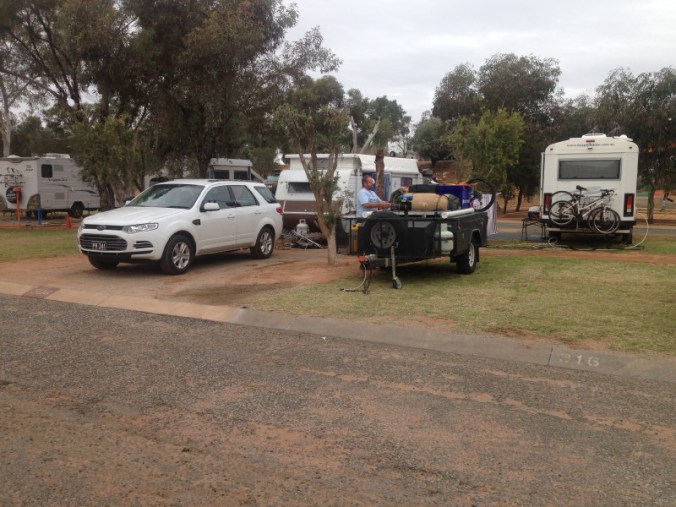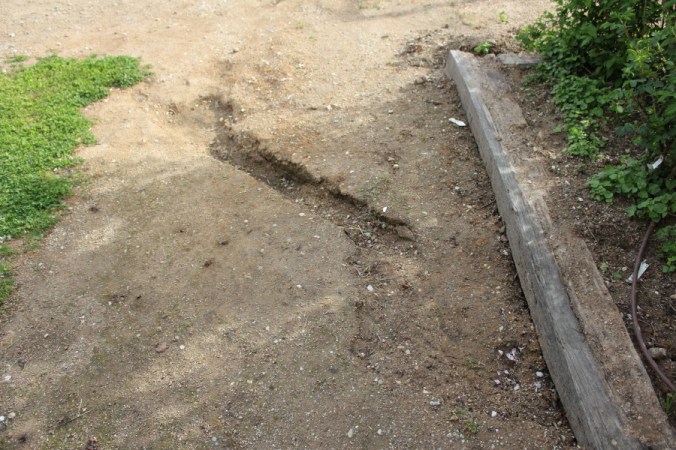Kata Tjuta – Valley of the Winds
Hi There,
The next day dawned bright and not a cloud in sight, a bit different from yesterdays weather at Uluru(see part 11). Todays adventure was being held at Kata Tjuta aka the Olga’s. Another amazing landform not far from Uluru with rich cultural attachments for the local people.

Kata Tjuta is Pitjantjatjara meaning ‘many heads’, clearly evident in the above photo how they got to that name! More formally you would describe it as an imposing series of mounds and domes that rise out of the surrounding landscape to an astonishing height of 546 metres above the plane(or 1066 metres above sea level). That’s a staggering 200 metres(roughly) taller than Uluru(Ayres Rock), yet I don’t think it is as well-known as Uluru. I suppose the difference is you can’t climb Kata Tjuta whereas you can Uluru occasionally! What is it with us white fella’s wanting to climb and stomp over everything anyway… I digress, there will be no more political leanings or thoughts from now on! As is the case with Uluru, these rock formations are just the tip of a huge slab of conglomerate that may extend up to 6 kilometres underground. What is conglomerate? I will get to that later!
 These two photos were taken from the dune viewing area where there were some interesting plants to check out as well, always a good thing.
These two photos were taken from the dune viewing area where there were some interesting plants to check out as well, always a good thing.
 This is the Broad leaf Parakeelya, Calandrinia balonensis, an annual or perennial growing to 30cm either way with a basal rosette of fleshy linear to lanceolate leaves up to 10 cm long and 1 cm wide. A good indicator plant of recent good rain, if there’s a good number and they are of a good size-this indicates recent good rain as they grow rapidly during wet seasons and store water for the dry times. It has a small purple poppy like flower on tallish stems that dance around in the breeze, if there is one!
This is the Broad leaf Parakeelya, Calandrinia balonensis, an annual or perennial growing to 30cm either way with a basal rosette of fleshy linear to lanceolate leaves up to 10 cm long and 1 cm wide. A good indicator plant of recent good rain, if there’s a good number and they are of a good size-this indicates recent good rain as they grow rapidly during wet seasons and store water for the dry times. It has a small purple poppy like flower on tallish stems that dance around in the breeze, if there is one!

Also from the dune viewing platform, you can swivel 90 degrees to the right and this is what you see below.
 The only other imposing rock that’s around here! The tree’s you see in the distance are Desert Oak, Allocasuarina decaisneana , also look at the first two photos of this post, the majority are all Desert Oak, quite common across the spinifex grasslands. Juvenile Desert Oak are quite different in appearance compared to mature examples. More will be revealed about these trees in a future post! Now lets head off and have a look at this place.
The only other imposing rock that’s around here! The tree’s you see in the distance are Desert Oak, Allocasuarina decaisneana , also look at the first two photos of this post, the majority are all Desert Oak, quite common across the spinifex grasslands. Juvenile Desert Oak are quite different in appearance compared to mature examples. More will be revealed about these trees in a future post! Now lets head off and have a look at this place.
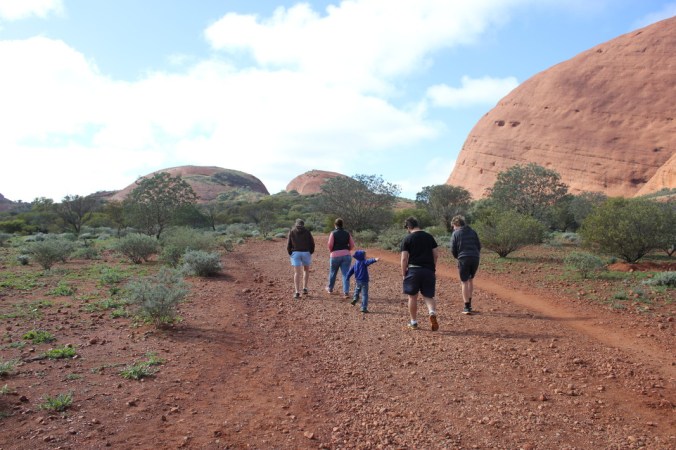
 Kata Tjuta is a Anangu mens site and sacred under traditional law, which means for us tourists there is no wandering off the pathways. There are plenty of different walks here and lots to see, so as we meander along, please stay with me! No wandering off! Note in the above photo the puddle of water which is a byproduct of rain we had here the day before. If you have read part 11 of this series you would realise this, but now we were enjoying the crisp sunshine, it is winter by the way! A balmy 17 degrees Celsius! You can see a bunch of people above, and to their left a green patch. I will concentrate on that now, the patch that is.
Kata Tjuta is a Anangu mens site and sacred under traditional law, which means for us tourists there is no wandering off the pathways. There are plenty of different walks here and lots to see, so as we meander along, please stay with me! No wandering off! Note in the above photo the puddle of water which is a byproduct of rain we had here the day before. If you have read part 11 of this series you would realise this, but now we were enjoying the crisp sunshine, it is winter by the way! A balmy 17 degrees Celsius! You can see a bunch of people above, and to their left a green patch. I will concentrate on that now, the patch that is.
 Here’s that green patch. Wanderrie grass , Eriachne scleranthoides , a very rare type of grass, see quote from Grasses of Australia, “Known from two localities in SW central Australia. Conglomerate monoliths (Mt Olga and Mt Currie) growing on crests, scree slopes, in chasms and crevices, in shallow sand, gravelly slopes or shallow stony red soil, sometimes in seepage from
Here’s that green patch. Wanderrie grass , Eriachne scleranthoides , a very rare type of grass, see quote from Grasses of Australia, “Known from two localities in SW central Australia. Conglomerate monoliths (Mt Olga and Mt Currie) growing on crests, scree slopes, in chasms and crevices, in shallow sand, gravelly slopes or shallow stony red soil, sometimes in seepage from
massive boulders. Flowers May (late-autumn) and Aug.-Oct. (late-winter to mid-spring)”. Above we have a seepage area on a scree slope, which is where it likes to grow.
 Quite a sharp prickly grass, looks more shrub like though doesn’t it! Even closer below.
Quite a sharp prickly grass, looks more shrub like though doesn’t it! Even closer below.
 This is a problem I find, I get distracted by things off to the side of the pathway and lo and behold the next time I look up the family is gone!! I’m sure I’ll catch them somewhere.
This is a problem I find, I get distracted by things off to the side of the pathway and lo and behold the next time I look up the family is gone!! I’m sure I’ll catch them somewhere.


The remarkable thing about Kata Tjuta is that it’s composed of a different type of rock than what Uluru(made of sandstone) is which is only 50 kilometres away(by road, 32 as the crow flies). Katu Tjuta is a conglomerate, a gravel consisting of pebbles, boulders and cobbles cemented by sand and mud. Conglomerate is also a sedimentary type rock. From a distance Kata Tjuta looks like the other big rock just around the corner, but up close its quite rough, see below photo.
 Don’t know why, but I found this quite fascinating. Here in the middle of no where, the only two objects that rise above the plain separated by a mere 50 kilometres are made of completely different rock. I’m sure this happens everywhere, but I just found it fascinating.. Click HERE for more geology information on this rock formation. If this was originally a huge slab of rock, how did it become domes and valleys? This is likely to be mechanical erosion of sand from the rock and other chemical erosion caused by moisture. The major Valley may have been fractured from the time of the Alice Springs Orogeny. Chemical weathering due to ground water widened the fissures and rainwater run off gradually formed the domes and canyons we now see.
Don’t know why, but I found this quite fascinating. Here in the middle of no where, the only two objects that rise above the plain separated by a mere 50 kilometres are made of completely different rock. I’m sure this happens everywhere, but I just found it fascinating.. Click HERE for more geology information on this rock formation. If this was originally a huge slab of rock, how did it become domes and valleys? This is likely to be mechanical erosion of sand from the rock and other chemical erosion caused by moisture. The major Valley may have been fractured from the time of the Alice Springs Orogeny. Chemical weathering due to ground water widened the fissures and rainwater run off gradually formed the domes and canyons we now see.
 Now for some more wildflowers. Look at that patch of Pussytails, Ptilotis.
Now for some more wildflowers. Look at that patch of Pussytails, Ptilotis.

Closer view here. This is actually Hairy Mulla Mulla, Ptilotus helipteroides . The stems and leaves have a persistent covering of medium to dense hairs, giving it its common name.
 It is an annual herb growing to about 50cm and usually occurs on rocky or gravelly ranges, hills or rises and on acidic rock and also found in Mulga dominated red plains and other locations.
It is an annual herb growing to about 50cm and usually occurs on rocky or gravelly ranges, hills or rises and on acidic rock and also found in Mulga dominated red plains and other locations.
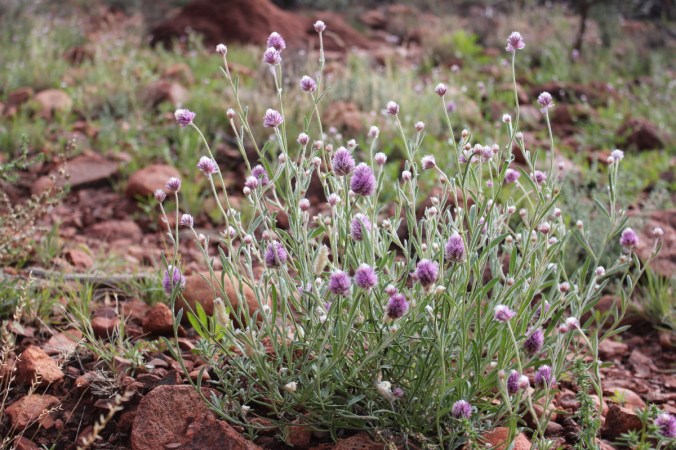
Flowering from June until November, now for a real close-up!
 We were heading to the Valley of the Winds and eventually the Karingana lookout, a return trip of 2.5 hours on a grade 4 – difficult track according to the visitor guide. I think it was more in line with moderate track! Here we are well into the Valley of the Winds and yes it was slightly breezy here!
We were heading to the Valley of the Winds and eventually the Karingana lookout, a return trip of 2.5 hours on a grade 4 – difficult track according to the visitor guide. I think it was more in line with moderate track! Here we are well into the Valley of the Winds and yes it was slightly breezy here!
 It’s at this point in the above photo that if the temperature is over 36 deg Celsius at 11am, the track is closed. This is the Karu Lookout, impressive to say the last. Those mounds in the distance look like a flight of stairs, sort of!
It’s at this point in the above photo that if the temperature is over 36 deg Celsius at 11am, the track is closed. This is the Karu Lookout, impressive to say the last. Those mounds in the distance look like a flight of stairs, sort of!
 As you can see it is quite rocky here.
As you can see it is quite rocky here.
 Nothing amazing with the above photo, just showing more rock and more conglomerate, you can also see water seeping out from under that large slab. Below is a swathe of Hairy Mulla Mulla, quite impressive to see it like this in its natural environment.
Nothing amazing with the above photo, just showing more rock and more conglomerate, you can also see water seeping out from under that large slab. Below is a swathe of Hairy Mulla Mulla, quite impressive to see it like this in its natural environment.

 Again not a great photo but it just shows a lovely natural garden bed with no human influence! I read something recently which I hadn’t really thought of before and that was someone’s thought on grouping colours in the garden as we do, pastels here, bright hot colours over there and so on. The thought was (not exactly in these words)”Nature doesn’t separate plants into colour groupings, so I’m not going too. There is just a riot of colour throughout my garden”. I really liked that and it may just become my new mantra. Not sure what the old mantra was!!
Again not a great photo but it just shows a lovely natural garden bed with no human influence! I read something recently which I hadn’t really thought of before and that was someone’s thought on grouping colours in the garden as we do, pastels here, bright hot colours over there and so on. The thought was (not exactly in these words)”Nature doesn’t separate plants into colour groupings, so I’m not going too. There is just a riot of colour throughout my garden”. I really liked that and it may just become my new mantra. Not sure what the old mantra was!!

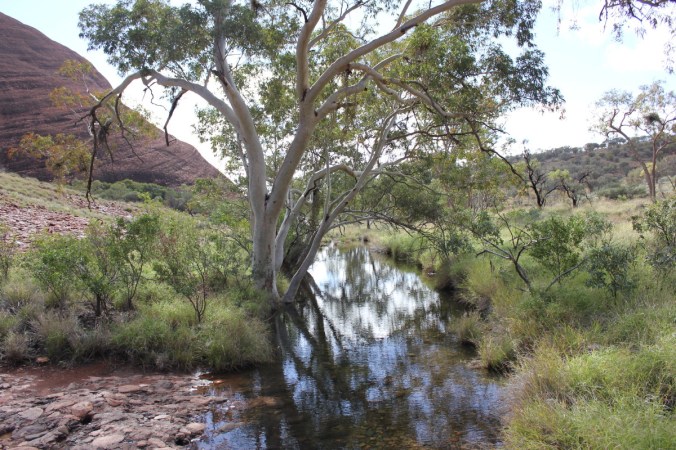 Lovely clear stream!
Lovely clear stream!
 These plants I have no idea at the moment what they are, they are a work in progress.
These plants I have no idea at the moment what they are, they are a work in progress.

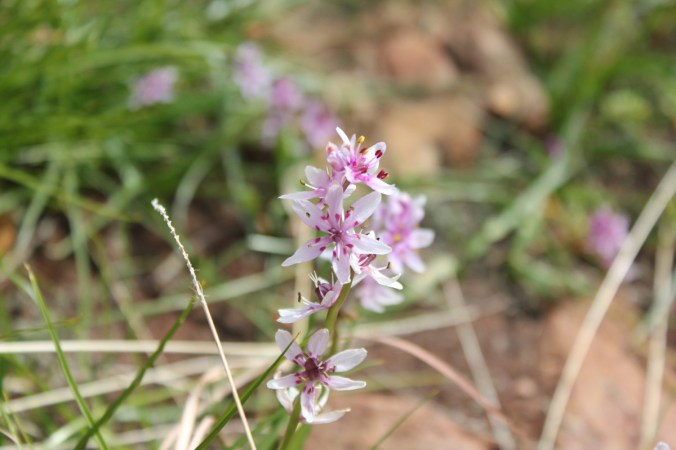 Pretty, never the less!
Pretty, never the less!

 In the above photo we are nearing the Karingana Lookout. You can see it in the distance, the high part in between the two walls. The walls of the domes just seemed to rise and rise into the bright noon day sun.
In the above photo we are nearing the Karingana Lookout. You can see it in the distance, the high part in between the two walls. The walls of the domes just seemed to rise and rise into the bright noon day sun. Well! We made it, what an amazing panorama greeted us!
Well! We made it, what an amazing panorama greeted us!

 Time to sit down for a quick bite to eat. The 3 oldest boys decided they would keep going on the circuit walk and us oldies along with our youngest lad turned back here. Here they are heading off at breakneck speed as per normal!
Time to sit down for a quick bite to eat. The 3 oldest boys decided they would keep going on the circuit walk and us oldies along with our youngest lad turned back here. Here they are heading off at breakneck speed as per normal!
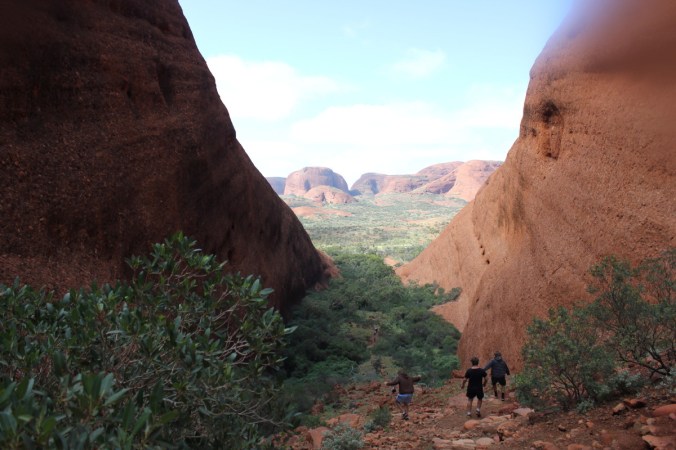 Below is another beautiful spot to recharge your batteries!
Below is another beautiful spot to recharge your batteries!

 Heading back to Karu Lookout. Below we have another Pussytail, Ptilotus exaltus , also known as Tall Mulla Mulla.
Heading back to Karu Lookout. Below we have another Pussytail, Ptilotus exaltus , also known as Tall Mulla Mulla.

 Grows to about 1.5 metres tall forming large showy drifts in open scrub and mulga country. The flowers start off cone shape then eventually lengthen to be elongated and cylindrical 3-20cm in length and 4.5cm in diameter. Compare the above two photos. The leaves are quite thick and rubbery looking, flowering from early spring until summer. Widespread across all mainland states. Here’s a small drift of them below.
Grows to about 1.5 metres tall forming large showy drifts in open scrub and mulga country. The flowers start off cone shape then eventually lengthen to be elongated and cylindrical 3-20cm in length and 4.5cm in diameter. Compare the above two photos. The leaves are quite thick and rubbery looking, flowering from early spring until summer. Widespread across all mainland states. Here’s a small drift of them below.

 Simply gorgeous!
Simply gorgeous!
Below is another plant that has featured in quite a few of these Northern Territory posts. Solanum quadriloculatum
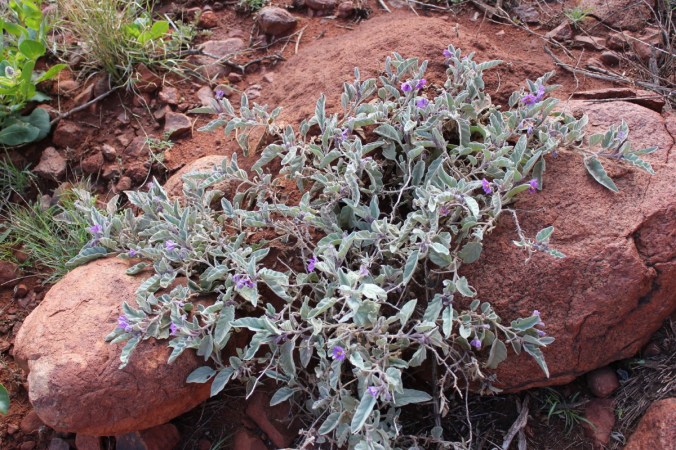 Another plant we saw was , Hakea subarea . This small tree also made an appearance at Ormiston Gorge. Click HERE if you can’t remember!
Another plant we saw was , Hakea subarea . This small tree also made an appearance at Ormiston Gorge. Click HERE if you can’t remember!
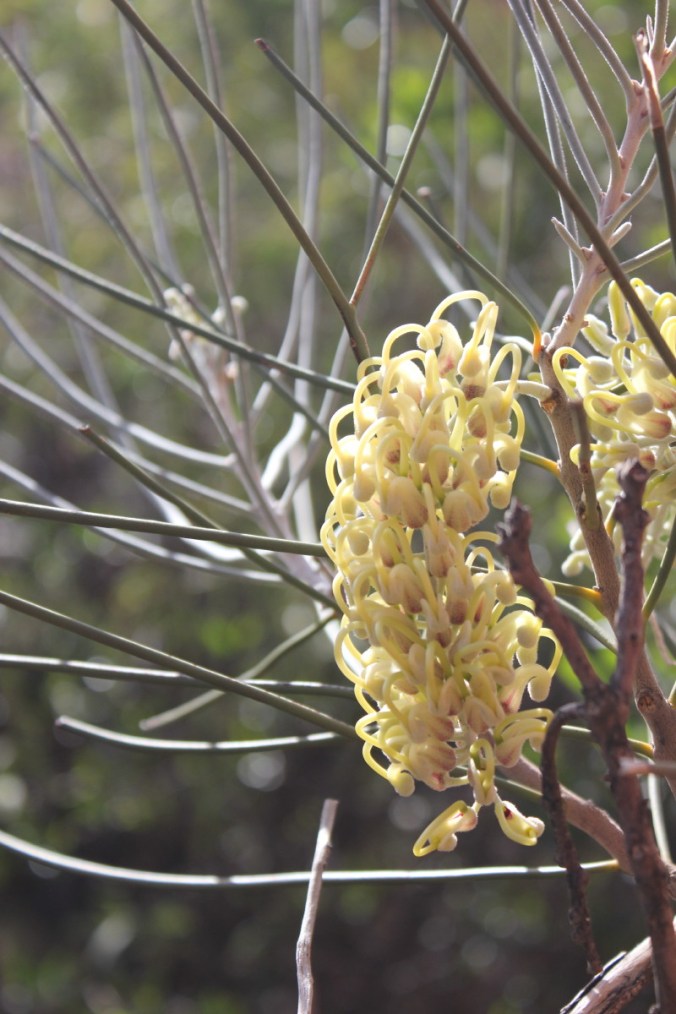 Here’s a beautiful Eremophila as well. Quite possibly Eremophila latrobei .
Here’s a beautiful Eremophila as well. Quite possibly Eremophila latrobei .

 Some walls for perspective! Note the little pocket of green three-quarters of the way up. Plants Hey! Amazing.
Some walls for perspective! Note the little pocket of green three-quarters of the way up. Plants Hey! Amazing.

More tall walls, this one below includes small people, well not small people, just normal ones!
 This is a small person one though!
This is a small person one though!
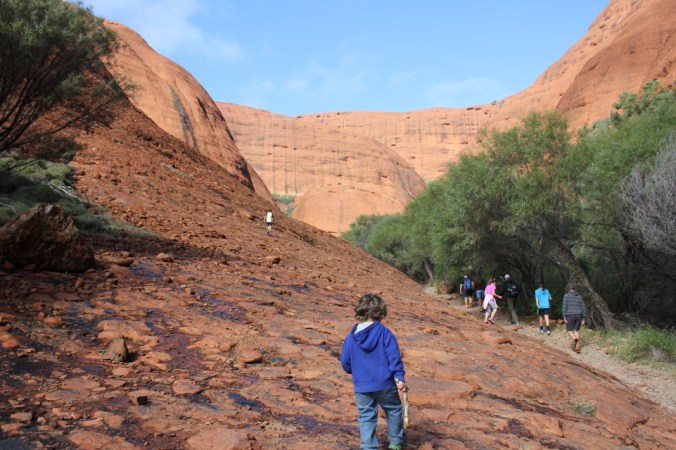 He’s also carrying a firearm( a gun I was told!).
He’s also carrying a firearm( a gun I was told!).

 Here are some more flowering meadows(for want of a better word) which were good to see.
Here are some more flowering meadows(for want of a better word) which were good to see.



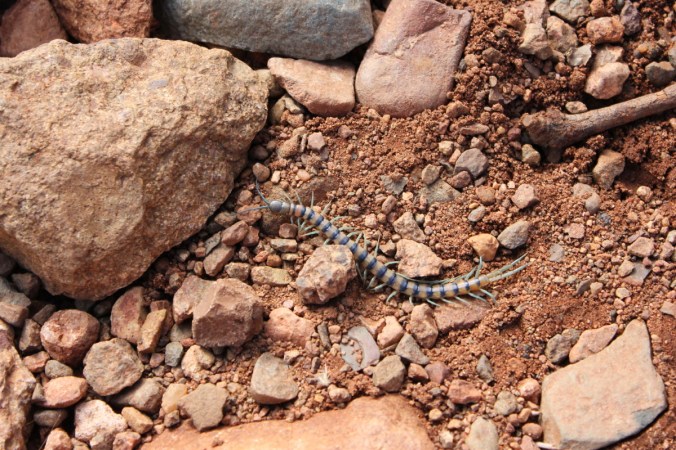 Oops! forgot about this little fellow. sorry!
Oops! forgot about this little fellow. sorry!
This plant below is Cattle bush or Camel bush. Yet again you see the need for scientific names!! Two common names for the same plant, not confusing at all! It is actually Trichodesma zeylanicum . A perennial plant growing to 1 metre occurring on rocky hills and sand dunes, stony alluvial soils or areas subjected to seasonal flooding, flowering in winter and spring.

 It was originally eaten by camels in the outback, hence one of its common names. One presumes then that cattle also ate or still eat it! Summer forage option! Here’s a few more random plant photos!
It was originally eaten by camels in the outback, hence one of its common names. One presumes then that cattle also ate or still eat it! Summer forage option! Here’s a few more random plant photos!
More stunning scenery!

Here’s one last plant I noticed when we had nearly finished the Valley of the Winds Circuit walk. I walked right past this on the way in! Go figure.
 Obviously a Brachyscome of some description, beautiful anyway.
Obviously a Brachyscome of some description, beautiful anyway.

 A nice sculpture below. The dead tree that is.
A nice sculpture below. The dead tree that is.
 Now we are nearly back to the start of this circuit walk. We did another small walk after this one but I will cover that next time round, i.e. part 12b! To finish off, I have added the below photos sans words as a parting gesture to the Valley of the Winds at Kata Tjuta. They speak for themselves!
Now we are nearly back to the start of this circuit walk. We did another small walk after this one but I will cover that next time round, i.e. part 12b! To finish off, I have added the below photos sans words as a parting gesture to the Valley of the Winds at Kata Tjuta. They speak for themselves!





 Cheers!
Cheers!
 Beautiful clear water with nice waves, quite rough when the wind was up otherwise it was calm.
Beautiful clear water with nice waves, quite rough when the wind was up otherwise it was calm.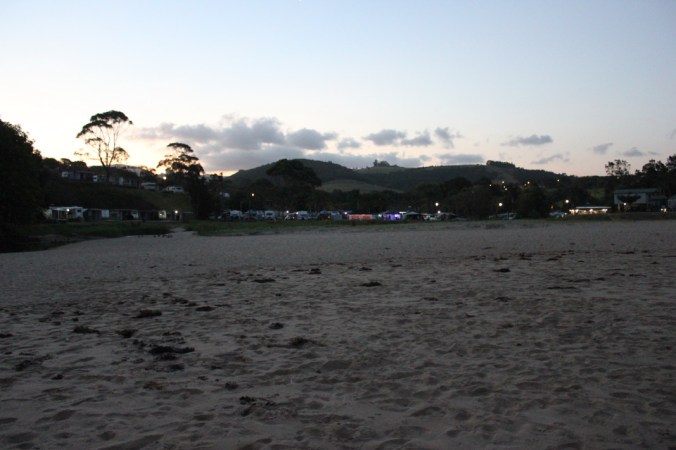 Sun has just set behind the hills to the rear of Kiama which lead to the escarpment up to the plains around Bowral and Moss Vale. It’s quite a drop from Moss Vale through Knights Hill down to Kiama. The Budderoo National Park is here to which is spectacular. Here’s some nice rock pools at Kiama East Beach with the waves crashing in behind them!
Sun has just set behind the hills to the rear of Kiama which lead to the escarpment up to the plains around Bowral and Moss Vale. It’s quite a drop from Moss Vale through Knights Hill down to Kiama. The Budderoo National Park is here to which is spectacular. Here’s some nice rock pools at Kiama East Beach with the waves crashing in behind them!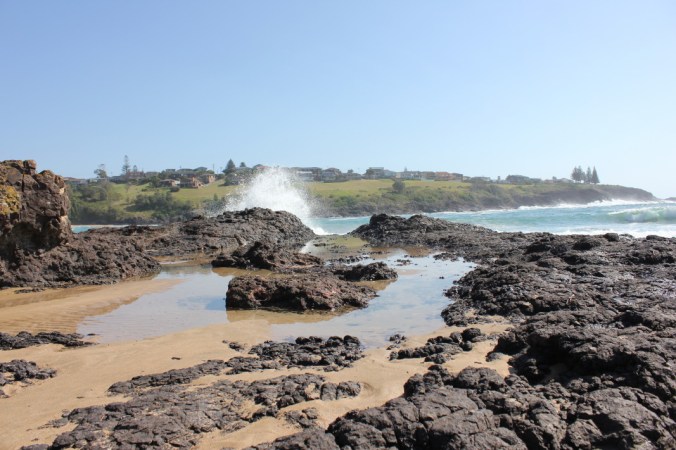
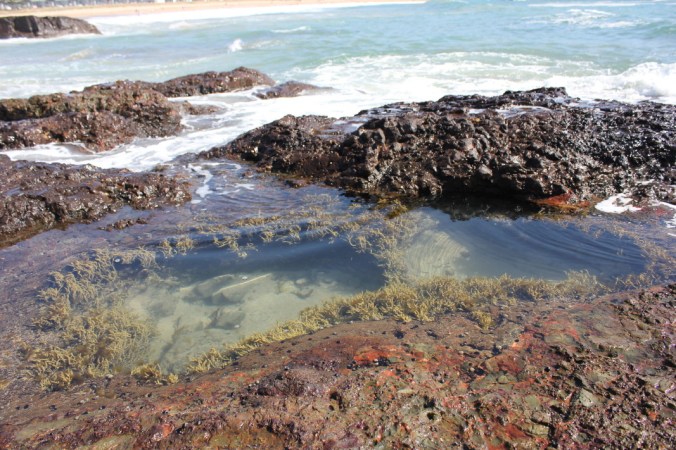

 More kids contemplating the ocean.
More kids contemplating the ocean.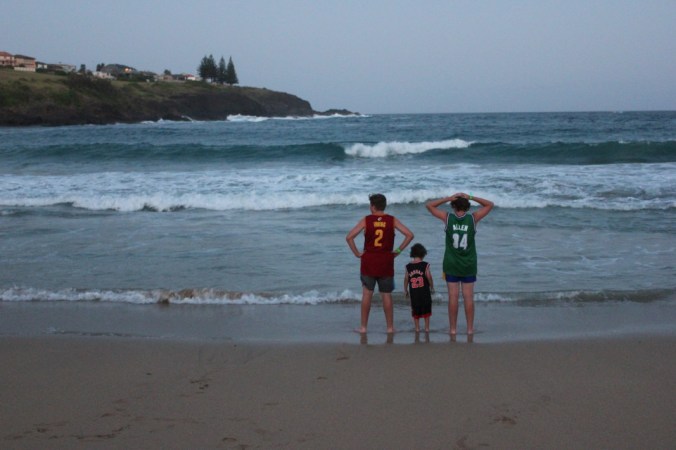 Around Kiama there a couple of Blowholes. A large one and a small one. When we were there the small one was outpacing the large one by a country mile. That’s a long way by the way!
Around Kiama there a couple of Blowholes. A large one and a small one. When we were there the small one was outpacing the large one by a country mile. That’s a long way by the way!
 Above we have some tourists waiting for the action and below we have the small blow-hole from a distance.
Above we have some tourists waiting for the action and below we have the small blow-hole from a distance. The coastline here is quite impressive and there’s a lovely walk along it in either direction from the caravan park. Here a some photos of the sea crashing into the coastline.
The coastline here is quite impressive and there’s a lovely walk along it in either direction from the caravan park. Here a some photos of the sea crashing into the coastline.
 There’s something therapeutic about watching the waves roll in
There’s something therapeutic about watching the waves roll in
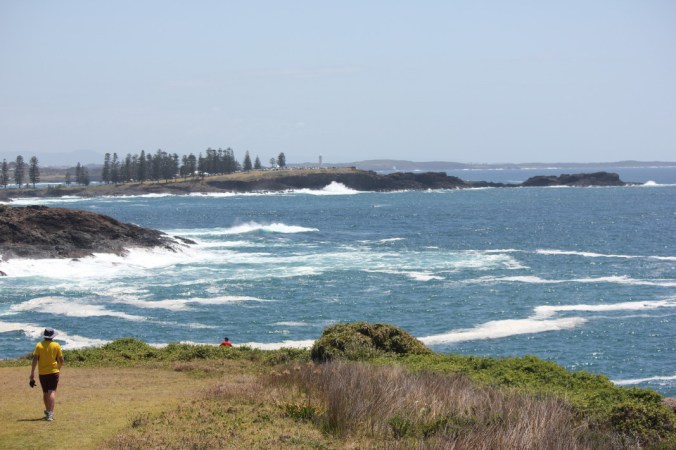 If you are looking for a great summer holiday. Kiama is the place to go! Stay tuned for future posts from this part of the world.
If you are looking for a great summer holiday. Kiama is the place to go! Stay tuned for future posts from this part of the world.

 Cheers!
Cheers! There was a trip to Kiama in January. More will be revealed later.
There was a trip to Kiama in January. More will be revealed later. There was some skiing action. More may be revealed later.
There was some skiing action. More may be revealed later.
 Spring Arrived. More will be revealed about this.
Spring Arrived. More will be revealed about this.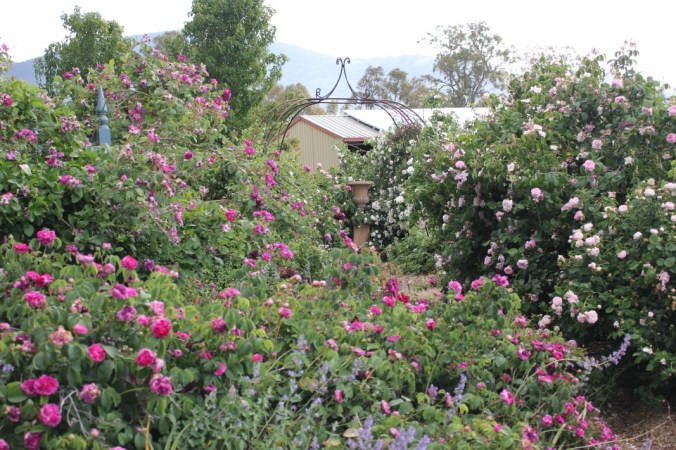 I think that will do. Obviously there’s a whole lot more that goes on with life but seriously, who’s interested in that. we go to work, we come home from work, we have tea, we go to the toilet, we sleep, we wake up, we go to work, we have morning tea, we come home, we have tea, we go to sleep, we wake up, we go to work, we have morning tea, we have lunch, we go to the toilet, we go home, we have tea, we go to sleep, we wake up. Get the picture!
I think that will do. Obviously there’s a whole lot more that goes on with life but seriously, who’s interested in that. we go to work, we come home from work, we have tea, we go to the toilet, we sleep, we wake up, we go to work, we have morning tea, we come home, we have tea, we go to sleep, we wake up, we go to work, we have morning tea, we have lunch, we go to the toilet, we go home, we have tea, we go to sleep, we wake up. Get the picture!
 These two photos were taken from the dune viewing area where there were some interesting plants to check out as well, always a good thing.
These two photos were taken from the dune viewing area where there were some interesting plants to check out as well, always a good thing. This is the Broad leaf Parakeelya, Calandrinia balonensis, an annual or perennial growing to 30cm either way with a basal rosette of fleshy linear to lanceolate leaves up to 10 cm long and 1 cm wide. A good indicator plant of recent good rain, if there’s a good number and they are of a good size-this indicates recent good rain as they grow rapidly during wet seasons and store water for the dry times. It has a small purple poppy like flower on tallish stems that dance around in the breeze, if there is one!
This is the Broad leaf Parakeelya, Calandrinia balonensis, an annual or perennial growing to 30cm either way with a basal rosette of fleshy linear to lanceolate leaves up to 10 cm long and 1 cm wide. A good indicator plant of recent good rain, if there’s a good number and they are of a good size-this indicates recent good rain as they grow rapidly during wet seasons and store water for the dry times. It has a small purple poppy like flower on tallish stems that dance around in the breeze, if there is one!
 The only other imposing rock that’s around here! The tree’s you see in the distance are Desert Oak, Allocasuarina decaisneana , also look at the first two photos of this post, the majority are all Desert Oak, quite common across the spinifex grasslands. Juvenile Desert Oak are quite different in appearance compared to mature examples. More will be revealed about these trees in a future post! Now lets head off and have a look at this place.
The only other imposing rock that’s around here! The tree’s you see in the distance are Desert Oak, Allocasuarina decaisneana , also look at the first two photos of this post, the majority are all Desert Oak, quite common across the spinifex grasslands. Juvenile Desert Oak are quite different in appearance compared to mature examples. More will be revealed about these trees in a future post! Now lets head off and have a look at this place.
 Kata Tjuta is a Anangu mens site and sacred under traditional law, which means for us tourists there is no wandering off the pathways. There are plenty of different walks here and lots to see, so as we meander along, please stay with me! No wandering off! Note in the above photo the puddle of water which is a byproduct of rain we had here the day before. If you have read part 11 of this series you would realise this, but now we were enjoying the crisp sunshine, it is winter by the way! A balmy 17 degrees Celsius! You can see a bunch of people above, and to their left a green patch. I will concentrate on that now, the patch that is.
Kata Tjuta is a Anangu mens site and sacred under traditional law, which means for us tourists there is no wandering off the pathways. There are plenty of different walks here and lots to see, so as we meander along, please stay with me! No wandering off! Note in the above photo the puddle of water which is a byproduct of rain we had here the day before. If you have read part 11 of this series you would realise this, but now we were enjoying the crisp sunshine, it is winter by the way! A balmy 17 degrees Celsius! You can see a bunch of people above, and to their left a green patch. I will concentrate on that now, the patch that is. Here’s that green patch. Wanderrie grass , Eriachne scleranthoides , a very rare type of grass, see quote from Grasses of Australia, “Known from two localities in SW central Australia. Conglomerate monoliths (Mt Olga and Mt Currie) growing on crests, scree slopes, in chasms and crevices, in shallow sand, gravelly slopes or shallow stony red soil, sometimes in seepage from
Here’s that green patch. Wanderrie grass , Eriachne scleranthoides , a very rare type of grass, see quote from Grasses of Australia, “Known from two localities in SW central Australia. Conglomerate monoliths (Mt Olga and Mt Currie) growing on crests, scree slopes, in chasms and crevices, in shallow sand, gravelly slopes or shallow stony red soil, sometimes in seepage from Quite a sharp prickly grass, looks more shrub like though doesn’t it! Even closer below.
Quite a sharp prickly grass, looks more shrub like though doesn’t it! Even closer below. This is a problem I find, I get distracted by things off to the side of the pathway and lo and behold the next time I look up the family is gone!! I’m sure I’ll catch them somewhere.
This is a problem I find, I get distracted by things off to the side of the pathway and lo and behold the next time I look up the family is gone!! I’m sure I’ll catch them somewhere.

 Don’t know why, but I found this quite fascinating. Here in the middle of no where, the only two objects that rise above the plain separated by a mere 50 kilometres are made of completely different rock. I’m sure this happens everywhere, but I just found it fascinating.. Click
Don’t know why, but I found this quite fascinating. Here in the middle of no where, the only two objects that rise above the plain separated by a mere 50 kilometres are made of completely different rock. I’m sure this happens everywhere, but I just found it fascinating.. Click  Now for some more wildflowers. Look at that patch of Pussytails, Ptilotis.
Now for some more wildflowers. Look at that patch of Pussytails, Ptilotis.
 It is an annual herb growing to about 50cm and usually occurs on rocky or gravelly ranges, hills or rises and on acidic rock and also found in Mulga dominated red plains and other locations.
It is an annual herb growing to about 50cm and usually occurs on rocky or gravelly ranges, hills or rises and on acidic rock and also found in Mulga dominated red plains and other locations.
 We were heading to the Valley of the Winds and eventually the Karingana lookout, a return trip of 2.5 hours on a grade 4 – difficult track according to the visitor guide. I think it was more in line with moderate track! Here we are well into the Valley of the Winds and yes it was slightly breezy here!
We were heading to the Valley of the Winds and eventually the Karingana lookout, a return trip of 2.5 hours on a grade 4 – difficult track according to the visitor guide. I think it was more in line with moderate track! Here we are well into the Valley of the Winds and yes it was slightly breezy here! It’s at this point in the above photo that if the temperature is over 36 deg Celsius at 11am, the track is closed. This is the Karu Lookout, impressive to say the last. Those mounds in the distance look like a flight of stairs, sort of!
It’s at this point in the above photo that if the temperature is over 36 deg Celsius at 11am, the track is closed. This is the Karu Lookout, impressive to say the last. Those mounds in the distance look like a flight of stairs, sort of! As you can see it is quite rocky here.
As you can see it is quite rocky here. Nothing amazing with the above photo, just showing more rock and more conglomerate, you can also see water seeping out from under that large slab. Below is a swathe of Hairy Mulla Mulla, quite impressive to see it like this in its natural environment.
Nothing amazing with the above photo, just showing more rock and more conglomerate, you can also see water seeping out from under that large slab. Below is a swathe of Hairy Mulla Mulla, quite impressive to see it like this in its natural environment.
 Again not a great photo but it just shows a lovely natural garden bed with no human influence! I read something recently which I hadn’t really thought of before and that was someone’s thought on grouping colours in the garden as we do, pastels here, bright hot colours over there and so on. The thought was (not exactly in these words)”Nature doesn’t separate plants into colour groupings, so I’m not going too. There is just a riot of colour throughout my garden”. I really liked that and it may just become my new mantra. Not sure what the old mantra was!!
Again not a great photo but it just shows a lovely natural garden bed with no human influence! I read something recently which I hadn’t really thought of before and that was someone’s thought on grouping colours in the garden as we do, pastels here, bright hot colours over there and so on. The thought was (not exactly in these words)”Nature doesn’t separate plants into colour groupings, so I’m not going too. There is just a riot of colour throughout my garden”. I really liked that and it may just become my new mantra. Not sure what the old mantra was!!
 Lovely clear stream!
Lovely clear stream! These plants I have no idea at the moment what they are, they are a work in progress.
These plants I have no idea at the moment what they are, they are a work in progress.
 Pretty, never the less!
Pretty, never the less!
 In the above photo we are nearing the Karingana Lookout. You can see it in the distance, the high part in between the two walls. The walls of the domes just seemed to rise and rise into the bright noon day sun.
In the above photo we are nearing the Karingana Lookout. You can see it in the distance, the high part in between the two walls. The walls of the domes just seemed to rise and rise into the bright noon day sun. Well! We made it, what an amazing panorama greeted us!
Well! We made it, what an amazing panorama greeted us!
 Time to sit down for a quick bite to eat. The 3 oldest boys decided they would keep going on the circuit walk and us oldies along with our youngest lad turned back here. Here they are heading off at breakneck speed as per normal!
Time to sit down for a quick bite to eat. The 3 oldest boys decided they would keep going on the circuit walk and us oldies along with our youngest lad turned back here. Here they are heading off at breakneck speed as per normal! Below is another beautiful spot to recharge your batteries!
Below is another beautiful spot to recharge your batteries!
 Heading back to Karu Lookout. Below we have another Pussytail, Ptilotus exaltus , also known as Tall Mulla Mulla.
Heading back to Karu Lookout. Below we have another Pussytail, Ptilotus exaltus , also known as Tall Mulla Mulla.
 Grows to about 1.5 metres tall forming large showy drifts in open scrub and mulga country. The flowers start off cone shape then eventually lengthen to be elongated and cylindrical 3-20cm in length and 4.5cm in diameter. Compare the above two photos. The leaves are quite thick and rubbery looking, flowering from early spring until summer. Widespread across all mainland states. Here’s a small drift of them below.
Grows to about 1.5 metres tall forming large showy drifts in open scrub and mulga country. The flowers start off cone shape then eventually lengthen to be elongated and cylindrical 3-20cm in length and 4.5cm in diameter. Compare the above two photos. The leaves are quite thick and rubbery looking, flowering from early spring until summer. Widespread across all mainland states. Here’s a small drift of them below.
 Simply gorgeous!
Simply gorgeous! Another plant we saw was , Hakea subarea . This small tree also made an appearance at Ormiston Gorge. Click
Another plant we saw was , Hakea subarea . This small tree also made an appearance at Ormiston Gorge. Click  Here’s a beautiful Eremophila as well. Quite possibly Eremophila latrobei .
Here’s a beautiful Eremophila as well. Quite possibly Eremophila latrobei .
 Some walls for perspective! Note the little pocket of green three-quarters of the way up. Plants Hey! Amazing.
Some walls for perspective! Note the little pocket of green three-quarters of the way up. Plants Hey! Amazing.
 This is a small person one though!
This is a small person one though! He’s also carrying a firearm( a gun I was told!).
He’s also carrying a firearm( a gun I was told!).
 Here are some more flowering meadows(for want of a better word) which were good to see.
Here are some more flowering meadows(for want of a better word) which were good to see.


 Oops! forgot about this little fellow. sorry!
Oops! forgot about this little fellow. sorry!
 It was originally eaten by camels in the outback, hence one of its common names. One presumes then that cattle also ate or still eat it! Summer forage option! Here’s a few more random plant photos!
It was originally eaten by camels in the outback, hence one of its common names. One presumes then that cattle also ate or still eat it! Summer forage option! Here’s a few more random plant photos!






 Obviously a Brachyscome of some description, beautiful anyway.
Obviously a Brachyscome of some description, beautiful anyway.
 A nice sculpture below. The dead tree that is.
A nice sculpture below. The dead tree that is. Now we are nearly back to the start of this circuit walk. We did another small walk after this one but I will cover that next time round, i.e. part 12b! To finish off, I have added the below photos sans words as a parting gesture to the Valley of the Winds at Kata Tjuta. They speak for themselves!
Now we are nearly back to the start of this circuit walk. We did another small walk after this one but I will cover that next time round, i.e. part 12b! To finish off, I have added the below photos sans words as a parting gesture to the Valley of the Winds at Kata Tjuta. They speak for themselves!



 Cheers!
Cheers! This is what a lot of the surrounding plant scape looks like, uninspiring you may say but you just need to look closely to find its beauty.
This is what a lot of the surrounding plant scape looks like, uninspiring you may say but you just need to look closely to find its beauty. Larapinta trail marker, this walking trail is 223km in length across the Macdonnell ranges, click on this
Larapinta trail marker, this walking trail is 223km in length across the Macdonnell ranges, click on this 
 Remember! Don’t just look ahead, cast your eye’s down and to the sides of where you’re walking, you’ll never know what you will find or see next.
Remember! Don’t just look ahead, cast your eye’s down and to the sides of where you’re walking, you’ll never know what you will find or see next.

 Below is Senna artemisoides subsp. artemisoides, another mouthful but a very beautiful shrub which grows to about 1-2 metres with beautiful yellow buttercup flowers in winter and spring.
Below is Senna artemisoides subsp. artemisoides, another mouthful but a very beautiful shrub which grows to about 1-2 metres with beautiful yellow buttercup flowers in winter and spring.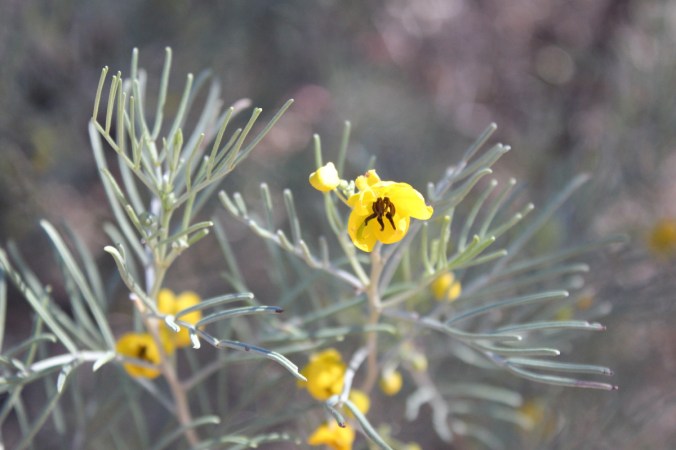
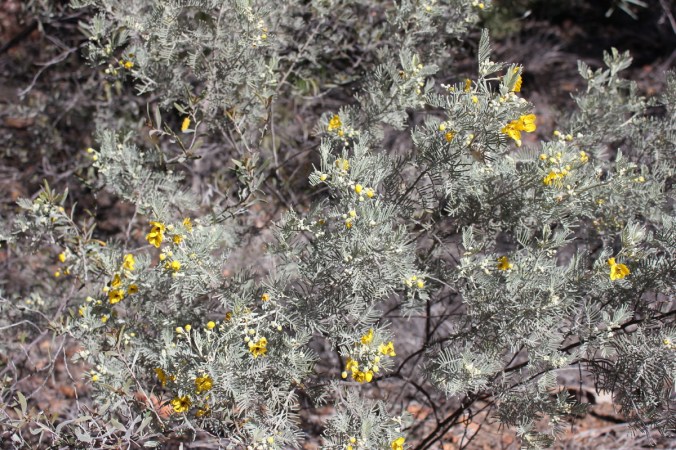 Maybe you can just call it the Silver Cassia. Now for an Emu Bush. Eremophila latrobei , commonly known as the Crimson Turkeybush, click
Maybe you can just call it the Silver Cassia. Now for an Emu Bush. Eremophila latrobei , commonly known as the Crimson Turkeybush, click 
 Another stunning Emu bush is Eremophila longifolia , also known as Berrigan, tall shrub to small tree weeping in form, click
Another stunning Emu bush is Eremophila longifolia , also known as Berrigan, tall shrub to small tree weeping in form, click  Sorry, I got distracted with the plants in the Serpentine Gorge, lets move onto the scenery. This is the first sort of glimpse of the gorge and it looks like its sort of straight up to the top, hmm!
Sorry, I got distracted with the plants in the Serpentine Gorge, lets move onto the scenery. This is the first sort of glimpse of the gorge and it looks like its sort of straight up to the top, hmm! Lets go for it! Now we are starting the climb up and here you can clearly see the parallel ridge lines that run through the Macdonnell Ranges.
Lets go for it! Now we are starting the climb up and here you can clearly see the parallel ridge lines that run through the Macdonnell Ranges.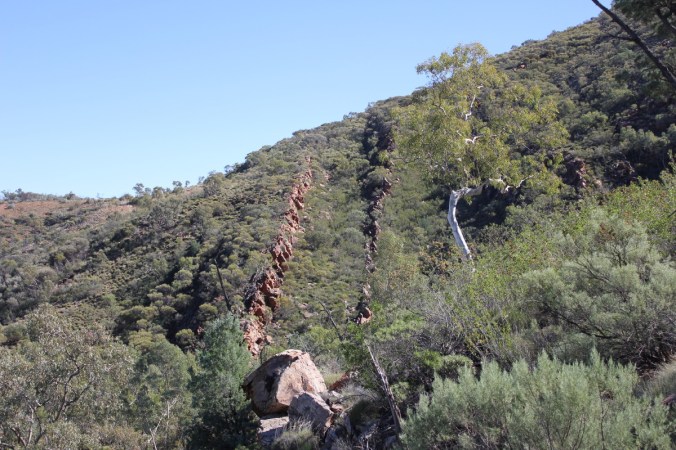 Another couple of views of those ridge lines
Another couple of views of those ridge lines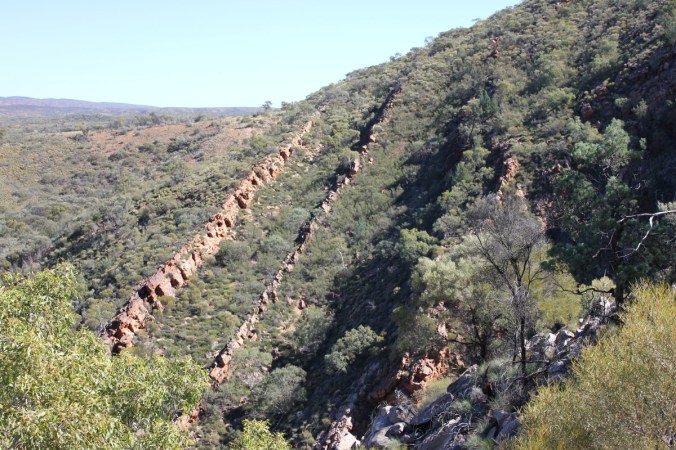
 Yes, as you can see above we are getting higher, quite spectacular! It is quite a rocky landscape and on these hillsides there is a lot of Porcupine grass, Trioda irritans. The last past of its botanic name sums it up very well indeed, very irritating because it’s quite prickly.
Yes, as you can see above we are getting higher, quite spectacular! It is quite a rocky landscape and on these hillsides there is a lot of Porcupine grass, Trioda irritans. The last past of its botanic name sums it up very well indeed, very irritating because it’s quite prickly.
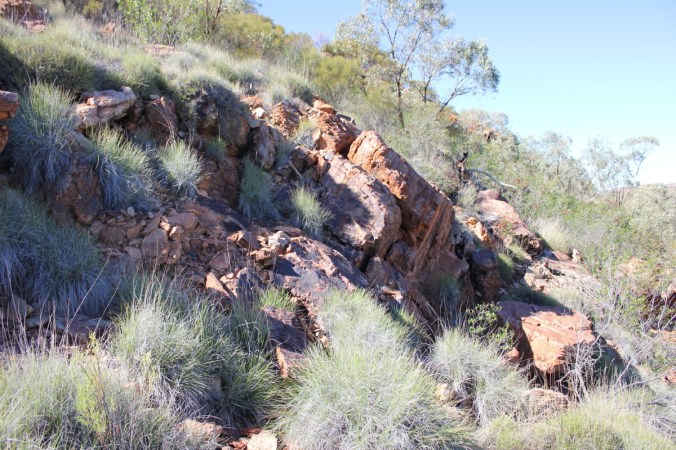 Below are more views across the valley.
Below are more views across the valley.
 Another plant of interest for me to see in the wild was Dodonaea viscosa , the Broad leaf Hop Bush or just plain Hop Bush, very common in gardens around the country and useful for many things from hedging to specimen plantings. It’s a very variable plant in the wild and widespread across the country.
Another plant of interest for me to see in the wild was Dodonaea viscosa , the Broad leaf Hop Bush or just plain Hop Bush, very common in gardens around the country and useful for many things from hedging to specimen plantings. It’s a very variable plant in the wild and widespread across the country.
 Now I know photos are great but there’s just no comparison to actually being there and seeing this landscape. I have a great digital SLR camera but it doesn’t capture the WOW! The size, scope and detail of what your eyes are looking at or what your feeling right then and there as you look at this amazing country. Below is the Serpentine Gorge.
Now I know photos are great but there’s just no comparison to actually being there and seeing this landscape. I have a great digital SLR camera but it doesn’t capture the WOW! The size, scope and detail of what your eyes are looking at or what your feeling right then and there as you look at this amazing country. Below is the Serpentine Gorge.


 Where does one go now from these heights? Down one would expect and lo and behold something I missed on the way up nearly hit me fair and square in the head on the way down.
Where does one go now from these heights? Down one would expect and lo and behold something I missed on the way up nearly hit me fair and square in the head on the way down. Leaning over the rocky pathway was this intriguing large shrub with what looked like stems twining around themselves like a climbing plant. This is Pandorea doratoxylon also known as the Spearwood Vine. The Aboriginal people use this plant for spears hence its common name. The long twining stems are light weight and are straightened and hardened over a fire. The flowers are quite pretty when one comes upon them in such a tough landscape.
Leaning over the rocky pathway was this intriguing large shrub with what looked like stems twining around themselves like a climbing plant. This is Pandorea doratoxylon also known as the Spearwood Vine. The Aboriginal people use this plant for spears hence its common name. The long twining stems are light weight and are straightened and hardened over a fire. The flowers are quite pretty when one comes upon them in such a tough landscape.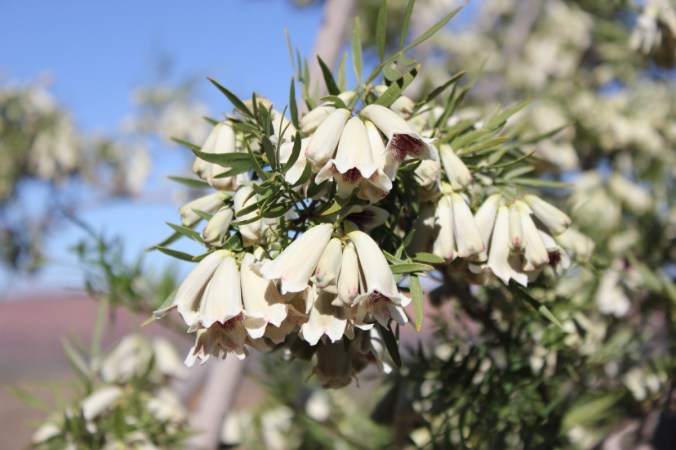 If they look familiar to you, you may be thinking of Pandorea jasminoides the Wonga Wonga vine or also known as the Bower Vine or one of the many hybrids available today. You would be correct because they are in the same family Bignoniaceae. Check out this closeup below!
If they look familiar to you, you may be thinking of Pandorea jasminoides the Wonga Wonga vine or also known as the Bower Vine or one of the many hybrids available today. You would be correct because they are in the same family Bignoniaceae. Check out this closeup below! This next photo doesn’t show too much, I just liked the detail of the bark. To me it tells a story of the harsh landscape in which it resides.
This next photo doesn’t show too much, I just liked the detail of the bark. To me it tells a story of the harsh landscape in which it resides. These next photos show an interesting Grevillea, the Holly Leaf Grevillea, Grevillea wickhamii. There are a few sub species but I’m not sure which one this is. I have pictures of this flowering at a different location which will be revealed at a later date!
These next photos show an interesting Grevillea, the Holly Leaf Grevillea, Grevillea wickhamii. There are a few sub species but I’m not sure which one this is. I have pictures of this flowering at a different location which will be revealed at a later date!
 You can see above that the new growth gives the plant a tinge of yellow which from a distance look like flowers.
You can see above that the new growth gives the plant a tinge of yellow which from a distance look like flowers.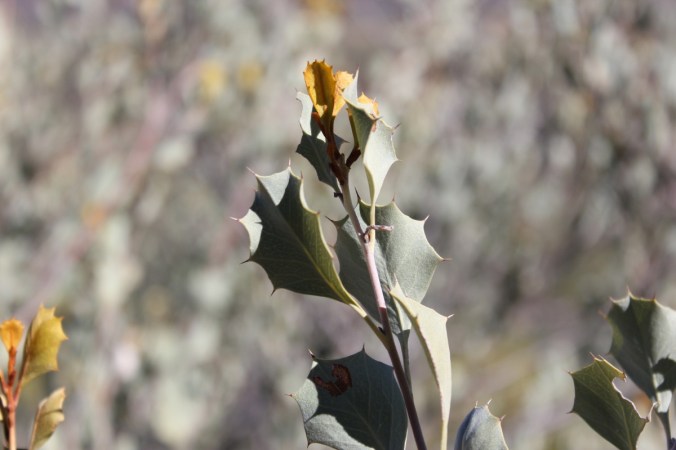 Some more plants of interest here included another beautiful Emu Bush, Eremophila freelingii. The Rock Fuchsia Bush.
Some more plants of interest here included another beautiful Emu Bush, Eremophila freelingii. The Rock Fuchsia Bush.
 A characteristic of this plant is that it sheds its lower leaves during drought to conserve moisture, you can see that quite clearly in the above photo, the plant looks half dead but it’s not! Grows to about 1.5 metres. The lilac flowers are stunning and are produced after it rains. Just a few more views below of this beautiful plant on the sides of Serpentine Gorge.
A characteristic of this plant is that it sheds its lower leaves during drought to conserve moisture, you can see that quite clearly in the above photo, the plant looks half dead but it’s not! Grows to about 1.5 metres. The lilac flowers are stunning and are produced after it rains. Just a few more views below of this beautiful plant on the sides of Serpentine Gorge.

 Funnily enough another surprise was what looked to be some type of Fern here as well and yes it was. Not sure of its identity but quite possibly Cheilanthes brownie , The Northern Rock Fern, either way still remarkable to me to see a fern out here. Nature is amazing.
Funnily enough another surprise was what looked to be some type of Fern here as well and yes it was. Not sure of its identity but quite possibly Cheilanthes brownie , The Northern Rock Fern, either way still remarkable to me to see a fern out here. Nature is amazing.
 Another interesting plant we saw was a parasite. Lysiana exocarpi , the Harlequin Mistletoe. This parasite is found mostly in inland locations and is very colourful.
Another interesting plant we saw was a parasite. Lysiana exocarpi , the Harlequin Mistletoe. This parasite is found mostly in inland locations and is very colourful.
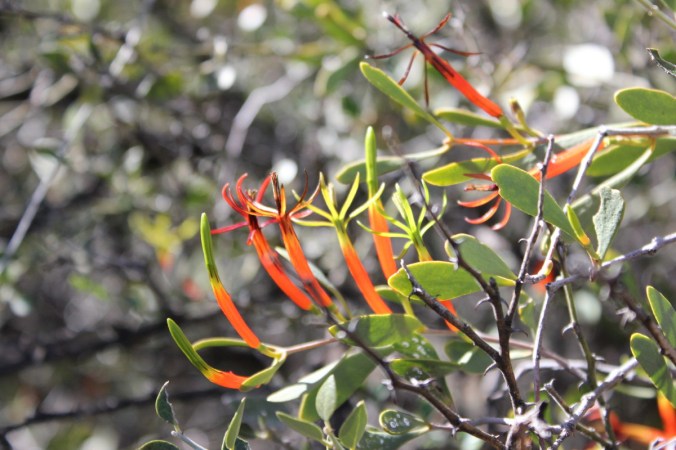 Now we have made it back down and headed into the cool of the gorge, being winter it wasn’t hot out in the open so one could imagine how nice and cool it would be in the heat of summer.
Now we have made it back down and headed into the cool of the gorge, being winter it wasn’t hot out in the open so one could imagine how nice and cool it would be in the heat of summer. In the above photo in the distance you can see some cycads, Macrozamia macdonnellii , the Macdonnell Ranges Cycad. Here they are below as well.
In the above photo in the distance you can see some cycads, Macrozamia macdonnellii , the Macdonnell Ranges Cycad. Here they are below as well. Ah well! That’s about it for the Serpentine Gorge, here’s a few last photos of plants and foliage.
Ah well! That’s about it for the Serpentine Gorge, here’s a few last photos of plants and foliage.












 Finally a last look into the gorge.
Finally a last look into the gorge. Cheers!
Cheers! Above is the Olive Python, Liasis olivaceus. My goodness this fella was huge, lucky the glass didn’t just vanish hey! Adults can reach over 4 metres in length, the second largest snake species in Australia. Dinner also includes the below pictured, Rock Wallaby, Yum! That’s quite a mouthful….
Above is the Olive Python, Liasis olivaceus. My goodness this fella was huge, lucky the glass didn’t just vanish hey! Adults can reach over 4 metres in length, the second largest snake species in Australia. Dinner also includes the below pictured, Rock Wallaby, Yum! That’s quite a mouthful….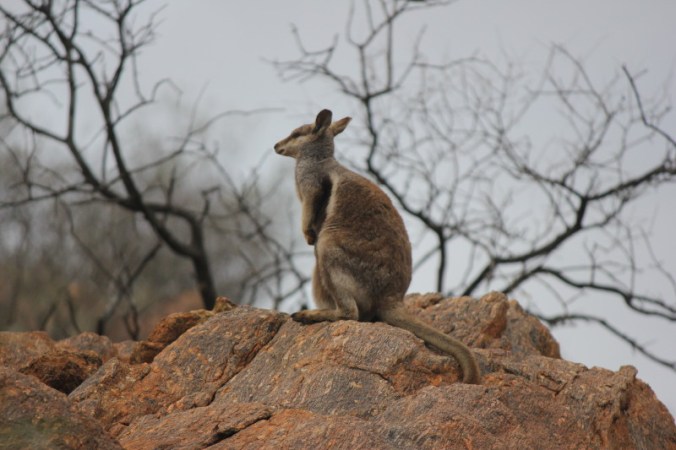

 Pogona vitticeps, aka the Central Bearded Dragon pictured below can grow up to 60cm in length with the tail accounting for approximately half of its length. Central Bearded Dragons can be seen with a range of different colours, browns, reddish-brown, red, white, orange and yellows.
Pogona vitticeps, aka the Central Bearded Dragon pictured below can grow up to 60cm in length with the tail accounting for approximately half of its length. Central Bearded Dragons can be seen with a range of different colours, browns, reddish-brown, red, white, orange and yellows.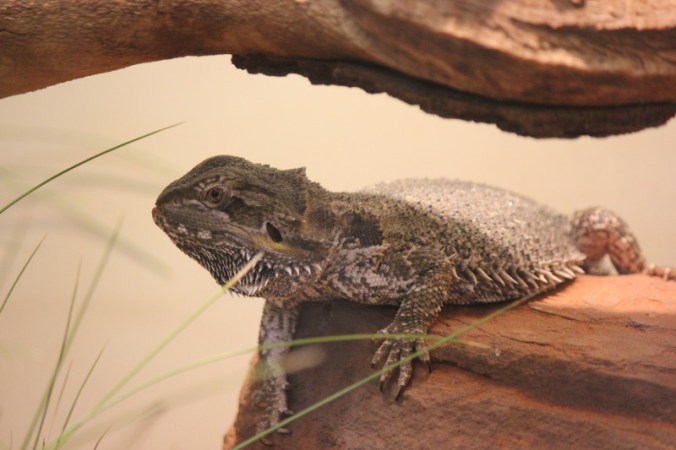 See his scary beard under his chin, used to intimidate would be tacklers! When threatened they flatten themselves, puff up their throats and open their jaws to look bigger and more fearsome. The photo below shows a different coloured Dragon, they change colour to regulate their temperature.
See his scary beard under his chin, used to intimidate would be tacklers! When threatened they flatten themselves, puff up their throats and open their jaws to look bigger and more fearsome. The photo below shows a different coloured Dragon, they change colour to regulate their temperature.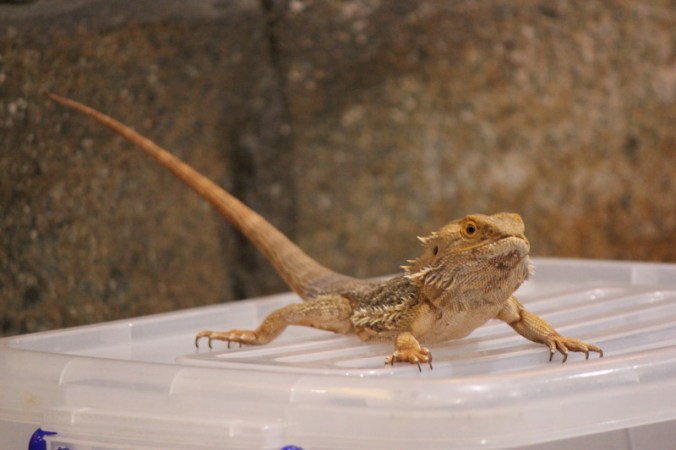 We were able to pass this fella around which was pretty cool! Quite soft to touch apart from his claws.
We were able to pass this fella around which was pretty cool! Quite soft to touch apart from his claws. Here is the Centralian Carpet Python, Morelia bredli growing to 2 metres and in captivity its known to get to 3 metres or more. Don’t think we need to dwell on this anymore, moving right along!!
Here is the Centralian Carpet Python, Morelia bredli growing to 2 metres and in captivity its known to get to 3 metres or more. Don’t think we need to dwell on this anymore, moving right along!!
 Talking about Brown snakes, here’s the King Brown, Pseudechis australis. Another one to give a miss or go the long way around!!
Talking about Brown snakes, here’s the King Brown, Pseudechis australis. Another one to give a miss or go the long way around!! Luckily its a bit out of focus so it wont see you!! Here’s a few more animals from the Alice Springs Reptile Centre.
Luckily its a bit out of focus so it wont see you!! Here’s a few more animals from the Alice Springs Reptile Centre.









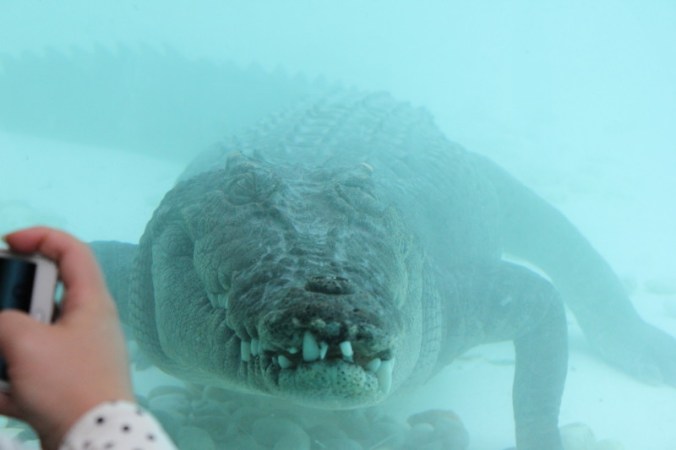 Never ever touch croc infested water, if you do you will be dead(most likely), vibration for them is like pollen to a honey bee. If you see their eyes break the water surface, you have just been triangulated, they know where you are. If you’re walking past croc infested waters – make sure you have a small dog with you. They are far more interested in small animals than they are in you. There is no such thing as a death roll, you are already dead, they are just trying to rip a piece of you off yourself because their hungry. They kill their prey by drowning them and it only takes a minute or so, no rolling required Their teeth are quite blunt and they tear pieces off, so that’s why you get rolled around. . See, not a death roll, more like a subway sub being prepared! So on that happy note, have a great day and look out for Terry!
Never ever touch croc infested water, if you do you will be dead(most likely), vibration for them is like pollen to a honey bee. If you see their eyes break the water surface, you have just been triangulated, they know where you are. If you’re walking past croc infested waters – make sure you have a small dog with you. They are far more interested in small animals than they are in you. There is no such thing as a death roll, you are already dead, they are just trying to rip a piece of you off yourself because their hungry. They kill their prey by drowning them and it only takes a minute or so, no rolling required Their teeth are quite blunt and they tear pieces off, so that’s why you get rolled around. . See, not a death roll, more like a subway sub being prepared! So on that happy note, have a great day and look out for Terry! Having ticked of several different lists, scratched my head more than a few times, what else do we need, what have I forgotten, do I need this if this happens? Time is fast approaching when the road will be calling us and I think we have everything packed, a bit late now if we haven’t! There is so many little things that you need to think about when your leaving on an extended holiday over what may include rough terrain. Major items may include bedding, clothing, food, cutlery, plates, cups, toilet paper, shovel. Did you swap the gas bottle over? Minor items may include, well what do you class minor, something that’s small? What about spare nuts and bolts, hose clamps, D shackles, tools, wire? I’m afraid nothing is small on a big trip like this, many things can go wrong.
Having ticked of several different lists, scratched my head more than a few times, what else do we need, what have I forgotten, do I need this if this happens? Time is fast approaching when the road will be calling us and I think we have everything packed, a bit late now if we haven’t! There is so many little things that you need to think about when your leaving on an extended holiday over what may include rough terrain. Major items may include bedding, clothing, food, cutlery, plates, cups, toilet paper, shovel. Did you swap the gas bottle over? Minor items may include, well what do you class minor, something that’s small? What about spare nuts and bolts, hose clamps, D shackles, tools, wire? I’m afraid nothing is small on a big trip like this, many things can go wrong. Morning tea saw us in Deniliquin for a quick cuppa and a fuel stop. Everything seemed to be holding together and the bikes were still behind us, always a good sign.
Morning tea saw us in Deniliquin for a quick cuppa and a fuel stop. Everything seemed to be holding together and the bikes were still behind us, always a good sign. Lunchtime had us in Balranald and it was still cold. I did have shorts on but always find that more comfortable to drive in than jeans or trousers. To me car interiors can become quite warm and make one sleepy. Not a good thing. We pressed on for Mildura then Cullulleraine for another fuel stop. By this stage the sun was truly starting to sink in the western sky. Our dream of reaching Morgan on day 1 was evaporating as I was not willing to risk dusk and night travelling through kangaroo infested territory. We headed for Renmark and decided to call it a day there.
Lunchtime had us in Balranald and it was still cold. I did have shorts on but always find that more comfortable to drive in than jeans or trousers. To me car interiors can become quite warm and make one sleepy. Not a good thing. We pressed on for Mildura then Cullulleraine for another fuel stop. By this stage the sun was truly starting to sink in the western sky. Our dream of reaching Morgan on day 1 was evaporating as I was not willing to risk dusk and night travelling through kangaroo infested territory. We headed for Renmark and decided to call it a day there. Camped by the Murray at a free camp site amongst the gum trees, wonderful, plenty of firewood! Wrong, there was no firewood. All those pesky campers before us had cleared any fallen wood out of there. Small twigs and plenty of bark had to suffice, amazingly we made do!
Camped by the Murray at a free camp site amongst the gum trees, wonderful, plenty of firewood! Wrong, there was no firewood. All those pesky campers before us had cleared any fallen wood out of there. Small twigs and plenty of bark had to suffice, amazingly we made do!
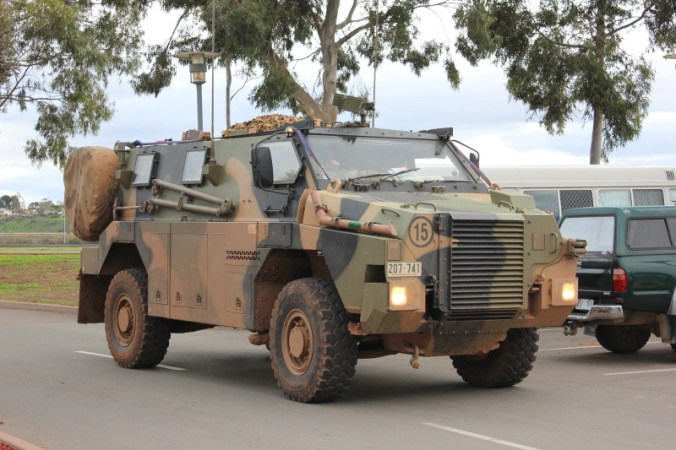 Bushmaster, now that’s one solid vehicle and even being in a Pajero ourselves as I pulled up beside one I was still looking up to its drivers window. We pushed on through Port Augusta, came to a roundabout. Left was the Eyre Highway and Western Australia, right was the Stuart Highway and the Northern Territory. Right it was and now we were really heading north. We made it to a destination I like to call “Somewhere on the Stuart Highway about 70km south of Pimba”.
Bushmaster, now that’s one solid vehicle and even being in a Pajero ourselves as I pulled up beside one I was still looking up to its drivers window. We pushed on through Port Augusta, came to a roundabout. Left was the Eyre Highway and Western Australia, right was the Stuart Highway and the Northern Territory. Right it was and now we were really heading north. We made it to a destination I like to call “Somewhere on the Stuart Highway about 70km south of Pimba”.



 You get use to the road trains pretty quick because they go all night long. Three or Four semi trailer behemoths all joined together rumbling along in the dark getting louder as they approach you. The other problem was the other type of train, lights piercing the darkness a rumbling noise getting louder and whoosh, a goods train rolls passed on to some far-flung destination. Lucky there was only 2 overnight.
You get use to the road trains pretty quick because they go all night long. Three or Four semi trailer behemoths all joined together rumbling along in the dark getting louder as they approach you. The other problem was the other type of train, lights piercing the darkness a rumbling noise getting louder and whoosh, a goods train rolls passed on to some far-flung destination. Lucky there was only 2 overnight.




